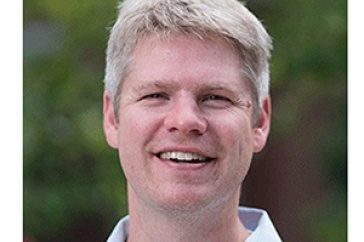The University of New Hampshire is a flagship research university that inspires innovation and transforms lives in our state, nation and world. More than 16,000 students from all 50 states and 71 countries engage with an award-winning faculty in top ranked programs in business, engineering, law, health and human services, liberal arts and the sciences across more than 200 programs of study. UNH’s research portfolio includes partnerships with NASA, NOAA, NSF and NIH, receiving more than $100 million in competitive external funding every year to further explore and define the frontiers of land, sea and space.
UNH Partners with Zillow on Research That Finds Homelessness Rate Increases Faster in Least Affordable Rental Markets

Chris Glynn, assistant professor of decision sciences at UNH's Peter T. Paul College of Business and Economics
DURHAM, N.H.—The expected homelessness rate in a community increases at an accelerated pace after rents reach 32 percent of the local median income, according to new research conducted by University of New Hampshire researcher Chris Glynn in partnership with Zillow.
According to Glynn and his collaborators at Boston University and the University of Pennsylvania, about a quarter of communities in the U.S. are above that 32 percent tipping point. Los Angeles is ground zero for the homelessness crisis with rents at 49 percent of the median income. Also above the 32 percent are New York City, Seattle, Washington, D.C., Boston, Atlanta and most of the West Coast.
“It is critical to understand what parts of the U.S. are struggling the most from a monitoring perspective,” said Glynn, assistant professor of decisions sciences at UNH and a research fellow with Zillow. “We found that when the share of income that goes to housing costs exceeds 32 percent, the homelessness rate increases much faster. In all the communities we analyzed, poverty is a strong contributor and expensive housing markets magnify its impact.”
Glynn noted that the general rule of thumb for how much of your income should be spent on housing is 30 percent, and these findings are evidence for that rule of thumb.
“There is a public health crisis unfolding in parts of the country,” he said. “Our findings provide insight on when and where homelessness populations may rapidly increase, information that is important to local, state and federal policymakers.”
The U.S. Department of Housing and Urban Development (HUD) estimates that 553,752 people nationwide experienced homelessness in 2017 based on a point-in-time count in January. Prior research shows these counts likely do not include the entire homeless population in the country, particularly those not in shelters. The actual number of people who were homeless is estimated to be closer to 661,000, roughly 20 percent higher than the officially reported population.
Overall, New Hampshire is more like the Midwest than neighboring states like Massachusetts and Maine. On average, the Granite State has one of the lowest homelessness rates, most affordable housing, and lowest rates of extreme poverty. In Manchester, however, 394 people were identified as homeless by HUD with a true number likely closer to 450 and the percent of median income that goes to housing is 33.9 percent.
Editors and producers: Chris Glynn, assistant professor of decision sciences at UNH, will participate in a roundtable discussion based on this new research today, Dec. 11. It will be livestreamed at https://www.zillowgroup.com/thought-leadership/events/ beginning at noon.
Latest News
-
December 4, 2025
-
November 26, 2025
-
November 6, 2025
-
November 5, 2025
-
October 24, 2025














































